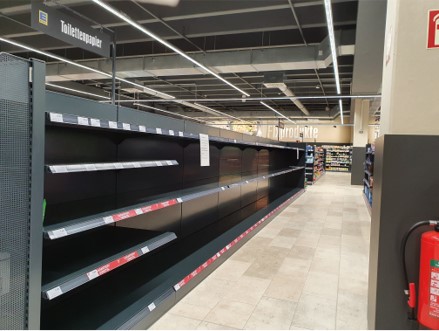I hope I can tell some interesting stories here just as the others:
I worked on a project for a pharmaceutical company, which wanted to have their dementia and cold cough products to be modeled, especially during coronavirus/COVID-19 infection. For the dementia product, we already saw a decreasing trend that were already active before the crisis. In the end we were 10% past the original sales outcome in our sales forecast, but COVID-19 not really influenced the use of dementia. Although these dementia products are normally also taken in case of sudden deafness (caused by stress) we saw no clear sign of COVID-19, or in other words unusual product specifics that may lead to a higher consumption due to stressful times during COVID-19 and homeschooling.
Thus, the negative trend in the year before was stronger than anticipated, but that was all. We decided to not incorporate any COVID-19 effects and it seemed right. Due to product specifics, we thought it was not correlated so high with COVID-19 lockdowns.
In case of the cold/cough product, you can imagine two scenarios:
- people get less sick because of lockdowns, and thus even in the main season of influenza, sales would break down
- people are stockpiling
We measured effects of coronavirus with dummies, and we already saw unusual activity in January, but I had not enough data to go on much more. The dummies aggregated to 3.000.000 € in sales. No one could have expected what happened:
Hell, after the modeling, the client had a target mismatch of about 50%, but not down; it was going up in early 2020. You can see that the time between January and March 2020 people got crazy on stockpiling. Man, every month they had 2/3 more this aggregated to nearly over 12,000,000!!!
For all three month in average, if we calculated normal seasonal sales we were under 10% in range of our target forecast in sales, but with coronavirus, phew.... And if you remember when coronavirus COVID-19 broke loose, people hoarded toilet paper like Stephan already pointed out, but hell they stockpiled everything that could help against symptoms.
After that I calculated several scenarios for, in Germany we would say: rumdümpeln von Infektionszahlen, by which I mean a shilly-shally of infection cases raising a little bit then going down and again the same thing little wave, up and down.
The other scenario was a lockdown that was lifted right before Christmas eve so that the retailers should profit from late Christmas business. I linked sales to the amount of infected cases. I relatively naively forecasted infected cases based on a Gaussian distribution for sales and infected cases, from week to week, where the top of the Gaussian distribution were already a negative sales impact, and showed a high infection of roughly a few thousand, as our highest number of infected cases up to there were solely 6,000 in Germany. That resulted in very high negative sales during late October till December.
Well, it seems that this modeling was correct in term of lockdown prediction, but as I now leave my company I will never know, how 'low' the sales really were in late 2020. Maybe someday someone will tell me if my amount of negative sales and my big lockdown scenario pointed in the correct direction.
I hope this was entertaining.

